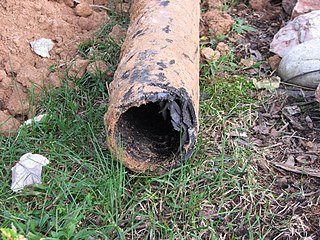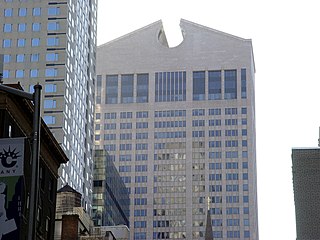
In telecommunication, the term outside plant has the following meanings:
Subterranean London refers to a number of subterranean structures that lie beneath London. The city has been occupied by humans for two millennia. Over time, the capital has acquired a vast number of these structures and spaces, often as a result of war and conflict.

A manhole cover or maintenance hole cover is a removable plate forming the lid over the opening of a manhole, an opening large enough for a person to pass through that is used as an access point for an underground vault or pipe. It is designed to prevent anyone or anything from falling in, and to keep out unauthorized persons and material.

Consolidated Edison, Inc., commonly known as Con Edison or ConEd, is one of the largest investor-owned energy companies in the United States, with approximately $12 billion in annual revenues as of 2017, and over $62 billion in assets. The company provides a wide range of energy-related products and services to its customers through its subsidiaries:

A power cable is an electrical cable, an assembly of one or more electrical conductors, usually held together with an overall sheath. The assembly is used for transmission of electrical power. Power cables may be installed as permanent wiring within buildings, buried in the ground, run overhead, or exposed. Power cables that are bundled inside thermoplastic sheathing and that are intended to be run inside a building are known as NM-B.

A utility tunnel, utility corridor, or utilidor is a passage built underground or above ground to carry utility lines such as electricity, steam, water supply pipes, and sewer pipes. Communications utilities like fiber optics, cable television, and telephone cables are also sometimes carried. One may also be referred to as a services tunnel, services trench, services vault, or cable vault. Smaller cable containment is often referred to as a cable duct or underground conduit. Direct-buried cable is a major alternative to ducts or tunnels.
Verizon New York, Inc., formerly The New York Telephone Company (NYTel), was organized in 1896, taking over the New York City operations of the American Bell Telephone Company.

A utility vault is an underground room providing access to subterranean public utility equipment, such as valves for water or natural gas pipes, or switchgear for electrical or telecommunications equipment. A vault is often accessible directly from a street, sidewalk or other outdoor space, thereby distinct from a basement of a building.

Frontier Communications Parent, Inc. is an American telecommunications company. Known as Citizens Utilities Company until 2000, Citizens Communications Company until 2008, and Frontier Communications Corporation until 2020, as a communications provider with a fiber-optic network and cloud-based services, Frontier offers broadband internet, digital television, and computer technical support to residential and business customers in 25 states. In some areas it also offers home phone services.
Centel Corporation was an American telecommunications company, with primary interests in providing basic telephone service, cellular phone service and cable television service.
The Capital Traction Company was the smaller of the two major street railway companies in Washington, D.C., in the early 20th century.

Orangeburg pipe is bituminized fiber pipe used in the United States. It is made from layers of ground wood pulp fibers and asbestos fibres compressed with and bound by a water resistant adhesive then impregnated with liquefied coal tar pitch. It was used from the 1860s through the 1970s, when it was replaced by PVC pipe for water supply and ABS pipe for drain-waste-vent (DWV) applications. The name comes from Orangeburg, New York, the town in which most Orangeburg pipe was manufactured, largely by the Fiber Conduit Company. It changed its name to the Orangeburg Manufacturing Company in 1948.

In civil engineering, undergrounding is the replacement of overhead cables providing electrical power or telecommunications, with underground cables. It helps in wildfire prevention and in making the power lines less susceptible to outages during high winds, thunderstorms or heavy snow or ice storms. An added benefit of undergrounding is the aesthetic quality of the landscape without the powerlines. Undergrounding can increase the capital cost of electric power transmission and distribution but may decrease operating costs over the lifetime of the cables.
Charles Francis Avila was an American electrical engineer and a Vice President and a member of the Executive Committee of the Yankee Atomic Electric Company.
The New York City Office of Technology and Innovation (OTI), formerly known as the Department of Information Technology and Telecommunications (DoITT), is the department of the government of New York City that oversees the City's "use of existing and emerging technologies in government operations, and its delivery of services to the public". Although the agency's primary purpose is to facilitate the technology needs of other New York City agencies, the department is best known by city residents for running the city's 311 "citizens' hotline," established in 2003. Its regulations are compiled in title 67 of the New York City Rules.

AT&T Corporation, commonly referred to as AT&T, an abbreviation for its former name, the American Telephone and Telegraph Company, was an American telecommunications company that provided voice, video, data, and Internet telecommunications and professional services to businesses, consumers, and government agencies.

Verizon Fios is a bundled Internet access, telephone, and television service provided by Verizon Communications that operates over a fiber optical network within the United States.

An electrical conduit is a tube used to protect and route electrical wiring in a building or structure. Electrical conduit may be made of metal, plastic, fiber, or fired clay. Most conduit is rigid, but flexible conduit is used for some purposes.
Stealth Communications is an American fiber-based Internet service provider (ISP), installing and maintaining its own fiber optic network throughout New York City. Stealth began rolling out its Gigabit Internet services in late 2013 to businesses throughout Manhattan, using in-house employees to lay its own fiber-optic cabling. In July 2015, City of New York and Stealth announced a $5.3 million public/private partnership to expand fiber broadband into the Brooklyn and Queens Industrial Business Zones. As of May 2019, the company reported to have connected hundreds of commercial properties with fiber, over 80 fiber route miles.













